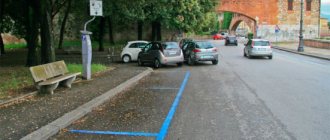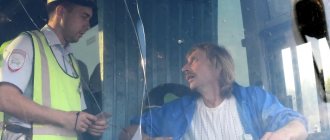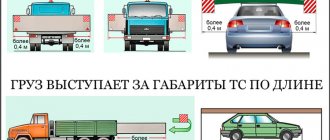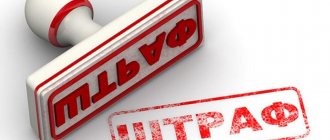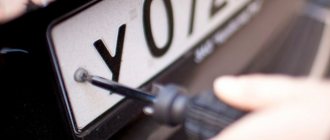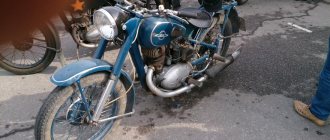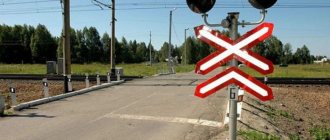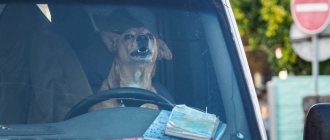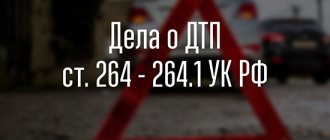general information
Special signals are used to notify other road users. Each of them has its own function; some are simply warning, while others require other road users to take some action.
The special signals specified in the third section of the traffic rules can only be used with the appropriate permission.
The list of structures entitled to use light and sound signals is established by the Government of the Russian Federation. In turn, officials of the established structures determine a specific list of cars on which means for providing light (sound) special signals will be installed.
Shades of flashing lights
Installed flashing lights can be of different shades. Each of them has its own purpose:
- Blue is installed on emergency services vehicles of all types.
- Blue and additional red. According to traffic regulations, special red-blue signals are allowed to be used only on vehicles of the State Traffic Inspectorate, the Military Traffic Inspectorate, and the Federal Security Service.
- White-lunar. It is used in federal postal transport and has a light stripe on a blue background on the outer side surface. Also, a white-lunar flashing light can be installed on vehicles transporting money and valuable cargo. Such machines must have special color graphics applied in accordance with Gosstandart.
- Orange, yellow color. These shades are used on vehicles performing construction, repair, and maintenance work on roads, when transporting large-sized, explosive, flammable, toxic, radioactive substances, as well as on vehicles accompanying vehicles carrying dangerous or oversized cargo.
Types of special signals
The following types of special signals are used on the territory of the Russian Federation:
- Blue flashing light. May be accompanied by an audible signal.
- Blue and red flashing lights. May be accompanied by an audible signal.
- Yellow or orange flashing light.
- White-lunar flashing light. May be accompanied by an audible signal.
Such a list is determined by the third section of the Traffic Rules. The same section establishes the rules for the use of light and sound special signals.
Blue and blue-red
The blue flashing light can be used by:
- Emergency medical service.
- Police (including traffic police).
- Fire service.
- Emergency services.
- Prosecutor's office.
- Transportation service of the Central Bank and Gokhran.
- Traffic police department of the military department.
- Special service of the Ministry of Communications.
- Intelligence agency of the Ministry of Justice.
- FSO.
- FSB.
Of these, a red light flashing beacon can be used by:
- Police.
- FSO.
- FSB.
- Traffic police department of the military department.
In this case, the red beacon can only be used in conjunction with the blue one, and not instead of it.
You can turn on the blue (blue-red) special signal only when performing an important, emergency official task: catching a criminal, going to a sick person or to a fire scene, etc. In particular, you can use a blue-red beacon when accompanying an organized convoy of vehicles (or one vehicle). In this case, the escorted vehicles are equal to those with special signals turned on.
When using blue or blue-red beacons, the driver may not comply with traffic signals, road sign rules, markings, etc. He can also move in the oncoming lane of traffic. The only thing is that the driver is prohibited from violating the signals of the traffic controller, but when he sees a car with special signals turned on, he is obliged to immediately provide passage for him. The driver can use his advantage only on the condition that he is convinced of the safety of road traffic, since he is not relieved of responsibility for the accident.
Having seen blue and red beacons and heard a sound signal, other road users must ensure unhindered passage of special vehicles: pull to the side of the road, give way at a turn (intersection), etc.
Pedestrians and cyclists who are planning to cross the road at an equipped crossing must stop and wait for vehicles with special signals on to pass.
All drivers are prohibited from overtaking a car with their lights on. The exception is when the specified vehicle is stationary. In this case, drivers must slow down to such a speed that they can stop immediately (as a rule, a stationary car with blue lights on indicates danger ahead).
Yellow or orange
The orange flashing light can be used by the following vehicles:
- When performing construction work;
- When repairing the roadway;
- When loading, transporting and unloading broken (broken) vehicles;
- When transporting dangerous goods: flammable (gasoline, diesel fuel), large, toxic, etc.;
- When transporting an organized group of children;
- When accompanying vehicles transporting dangerous goods;
- When accompanied by an organized group of cyclists or pedestrians.
You can turn on the beacon directly when performing the specified actions.
Yellow and orange special signals do not give drivers any advantage over other road users. They only report the increased danger of the vehicle and draw the attention of other drivers to this. At the same time, when performing construction, repair and some other work, vehicles are allowed to deviate slightly from the requirements of several road signs and types of markings. For example, they may ignore a “No Stopping or Parking” sign.
Lunar white
Lunar-white flashing lights can only be installed on postal vehicles and vehicles transporting valuable cargo: money, precious metals, etc. Thus, this signal is used by collection service vehicles.
The white-lunar beacon turns on only if there is a direct danger of an attack on the specified vehicle (for example, when trying to rob). In this case, the driver does not receive an advantage over other road users: he must also comply with the requirements of road signs, markings and other traffic rules.
The white-lunar beacon serves to attract attention so that eyewitnesses can notice an attempt to attack a vehicle with a special signal. Along with the beacon, a special sound siren is always turned on.
- 3.1
- 3.2
- 3.3
- 3.4
- 3.5
- 3.6
3. USE OF SPECIAL SIGNALS
When signaling the horn, always be fair, but strict.
K Prutkov
3.1
Drivers of vehicles with a blue flashing light on, when performing an urgent official task, may deviate from the requirements of sections 6 (except for traffic controller signals) and 8–18 of these Rules, appendices 1 and 2 to these Rules, provided that traffic safety is ensured.
To gain an advantage over other road users, drivers of such vehicles must turn on a blue flashing light and a special sound signal. They can take advantage of priority only after making sure that the road is being given way to them.
The same right is enjoyed by drivers of vehicles accompanied by vehicles with special color graphics applied to the outer surfaces, with blue and red flashing lights turned on and a special sound signal, in the cases established by this paragraph. The low beam headlights must be turned on for the escorted vehicles.
On vehicles of the State Road Safety Inspectorate of the Ministry of Internal Affairs of the Russian Federation, the Federal Security Service of the Russian Federation and the Military Automobile Inspectorate, in addition to the blue flashing light, a red flashing light may be turned on
Reader A:
Consequently, the driver of an emergency service vehicle with a blue flashing light turned on (Fig. 23) can move in any direction, despite the prohibiting traffic light signal and indications of signs?
Author:
Maybe, but only in this case, a special sound signal must be turned on on the car together with a blue beacon. In addition, its driver must make sure that other road users are giving way
Reader B:
And if on an operational vehicle equipped with a blue beacon, the beacon is not turned on, is it not necessary to give way?
Author:
Yes, then you will drive around with such a car in accordance with the requirements of the Rules as equal road users
Reader A:
Why is a red beacon included in addition to the blue flashing light?
Author:
To better attract the attention of all road users to such a vehicle, for example, when accompanying a convoy
3.2
When approaching a vehicle with a blue flashing light and a special sound signal on, drivers are required to give way to ensure unhindered passage of the specified vehicle
When approaching a vehicle that has special color schemes applied to the outer surfaces, with blue and red flashing lights turned on and a special sound signal, drivers are required to give way to ensure unhindered passage of the specified vehicle, as well as the vehicle (accompanied by it).
It is prohibited to overtake a vehicle that has special color schemes applied to the outer surfaces, with a blue flashing light and a special sound signal turned on.
It is prohibited to overtake a vehicle that has special color schemes applied to the outer surfaces, with blue and red flashing lights and a special sound signal turned on, as well as the vehicle (accompanied by it)
Reader B:
I realized that you always need to give way to a car that gives a special sound signal if it has a blue flashing light or blue and red on it.
Reader A:
Yes, and you can’t overtake such a humming car with sparkling beacons
Author:
You can’t overtake only if such a vehicle has special color schemes applied to the outer surface
I would also like to note that if such a car is accompanied by another vehicle or convoy, then you should give way to all escorted vehicles (Fig. 24)
Reader B:
How do I know that this particular vehicle is being accompanied by a car with a blue light and a special sound signal on?
Author:
Pay attention to the end of paragraph 3 2 of the Rules. You recognize these vehicles by the low beam headlights on.
Let me note once again that it is prohibited to overtake an escort vehicle with color schemes printed on it if blue-red lights are flashing on it and it gives special sound signals. You cannot overtake vehicles accompanied by such a special vehicle.
3.3
When approaching a stationary vehicle with a blue flashing light on, the driver should reduce speed to be able to stop immediately if necessary.
Reader A:
I don’t quite understand, if a car with a blue flashing light on is standing at the side of the road, then I should also stop my car?
Author:
No You just need to be prepared to stop moving immediately if necessary.
3.4
A flashing light of yellow or orange color must be turned on on vehicles when performing work on the construction, repair or maintenance of roads, loading and transporting damaged, faulty, as well as other vehicles in cases provided for by law, on vehicles participating in road traffic, dimensions which exceed the standards established by paragraph 23.5 of these Rules, as well as on vehicles transporting large, heavy loads, explosive, flammable, radioactive substances and toxic substances of a high degree of danger, and in cases established by special rules - on vehicles accompanying such transportation. A yellow or orange flashing light does not provide an advantage in traffic and serves to warn other road users of danger.
3.5
Drivers of vehicles with a yellow or orange flashing light turned on, when performing work on construction, repair or maintenance of roads, may deviate from the requirements of road signs (except for signs 2.2, 2.4–2.6, 3.11–3.14, 3.17.2, 3.20) and road markings, as well as paragraphs 9.4–9.8 and 16.1 of these Rules, provided that traffic safety is ensured. Drivers of vehicles participating in road traffic whose dimensions exceed the standards established by paragraph 23.5 of these Rules, vehicles transporting large-sized and (or) heavy cargo, and vehicles accompanying such transportation, with a yellow or orange flashing light on, may retreat from road marking requirements, provided traffic safety is ensured
Reader A:
Flashing beacons of orange or yellow color do not provide any advantage and there is no need to give way to such vehicles. Then the driver of the harvesting machine, despite the orange flashing light being on, must stop when the traffic light is prohibiting (Fig. 25) And when the traffic light is permissive, he can move in in any direction (Fig. 26), as it performs cleaning work.
3.6
Drivers of vehicles of federal postal organizations and vehicles transporting cash proceeds and/or valuable cargo can turn on a white-lunar flashing light and a special sound signal only when attacks on these vehicles. A white-lunar flashing light does not provide an advantage in traffic and serves to attract the attention of police officers and other persons.
Table of contents
Responsibility for illegal installation of special signals
As stated above, for unauthorized installation and use of means for sending special signals, administrative penalties may be applied to responsible persons in accordance with Article 12.4 of the Code of Administrative Offenses. Thus, paragraph 2 of the article provides for the following liability for the illegal installation of the special signals listed above:
- Individual – fine 5,000 rubles;
- The official who allowed the car to be used (provided that the car belongs to an organization) - a fine of 20,000 rubles;
- The legal entity that owns the car – a fine of 500,000 rubles.
Moreover, in all cases, in addition to the fine for flashing beacons, the removal and irrevocable confiscation of funds for issuing special signals is provided. The responsible person can be punished even if the driver did not turn on special signals, but was simply driving on public roads in the specified vehicle. If possible, the means for giving special signals will be confiscated right on the spot; if not, the car will be sent to the impound lot.
Rights of road users – what are the responsibilities of pedestrians and drivers?
Use of special signals - Traffic rules 2021
(as amended by Decree of the Government of the Russian Federation dated April 21, 2000 N 370)
3.1. Drivers of vehicles with a blue flashing light turned on, when performing an urgent official task, may deviate from the requirements of sections 6 (except for traffic controller signals) and 8-18 of these Rules, appendices 1 and 2 to these Rules of the Road, provided that traffic safety is ensured.
To gain an advantage over other road users, drivers of such vehicles must turn on a blue flashing light and a special sound signal. They can take advantage of priority only by making sure that they are given way.
The same right is enjoyed by drivers of vehicles accompanied by vehicles that have special color graphics applied to the outer surfaces, with blue and red flashing lights turned on and a special sound signal, in the cases established by this paragraph. Accompanied vehicles must have low beam headlights on.
On vehicles of the State Road Safety Inspectorate of the Ministry of Internal Affairs of the Russian Federation, the Federal Security Service of the Russian Federation and the Military Automobile Inspectorate, in addition to the blue flashing light, a red flashing light may be turned on.
3.2. When approaching a vehicle with a blue flashing light and a special sound signal on, drivers are required to give way to ensure unhindered passage of the specified vehicle.
When approaching a vehicle that has special color schemes applied to the outer surfaces, with blue and red flashing lights turned on and a special sound signal, drivers are required to give way to ensure unhindered passage of the specified vehicle, as well as the vehicle (accompanied by it).
It is prohibited to overtake a vehicle that has special color schemes applied to the outer surfaces with a blue flashing light and a special sound signal turned on.
It is prohibited to overtake a vehicle that has special color schemes applied to its external surfaces, with blue and red flashing lights turned on and a special sound signal, as well as the vehicle(s) it is accompanying.
3.3. When approaching a stationary vehicle with a blue flashing light on, the driver should reduce speed to be able to stop immediately if necessary.
3.4. A yellow or orange flashing light must be turned on on vehicles in the following cases:
- performing work on the construction, repair or maintenance of roads, loading damaged, faulty and moving vehicles;
- transportation of large cargo, explosive, flammable, radioactive substances and highly dangerous toxic substances;
- escort of vehicles transporting large, heavy and dangerous goods;
- accompanying organized groups of cyclists during training activities on public roads.
An illuminated yellow or orange flashing light does not provide an advantage in traffic and serves to warn other road users of danger.
3.5. Drivers of vehicles with a yellow or orange flashing light turned on may deviate from the requirements of road signs (except for signs 2.2, 2.4-2.6, 3.11-3.14, 3.17) when performing construction, repair or maintenance work on roads, loading damaged, faulty and moving vehicles. .2, 3.20) and road markings, as well as paragraphs 9.4—9.8 and 16.1 of these Rules, provided that road safety is ensured.
Drivers of vehicles when transporting large-sized cargo, as well as when escorting vehicles carrying large-sized and (or) heavy cargo, with a yellow or orange flashing light turned on, may deviate from the requirements of road markings, provided that road safety is ensured.
3.6. Drivers of vehicles of federal postal organizations and vehicles transporting cash proceeds and (or) valuable cargo may turn on a white-moon flashing light and a special sound signal only when attacking these vehicles.
A white-lunar flashing light does not provide an advantage in traffic and serves to attract the attention of police officers and other persons.
Misuse of Signals
According to traffic regulations, a car with a special signal must have permission to install and use warning devices of this type. If there is none, then turning on the flashing light and sound signal is regarded as an illegal act and is punishable by law.
Spontaneous installation of a special signal on transport entails a fine of 5,000 rubles, followed by confiscation of the subject of the offense. This is described in the Code of Administrative Offenses of the Russian Federation, Part 2, Art. 12.4.
If suddenly the offender pays the fine within twenty days from the date of the decision, then the amount of the fine is halved, i.e. he will pay not 5,000 rubles, but half the amount - 2,500 rubles. In other cases, the fine is paid in full (Administrative Code of the Russian Federation, Part 1, Article 32.2).
Responsibility
As stated in the traffic rules, the use of a special signal is illegal, and anyone who drove a vehicle with a flashing light or sound signal installed without the appropriate permission is subject to administrative liability. Such drivers are deprived of their driving privileges for a period of one to one and a half years. Illegal devices installed on the car are eliminated (part 4 of article 12.5 of the Code of Administrative Offenses of the Russian Federation).
Turning on special signals while driving without permission threatens the driver with deprivation of the right to drive for up to two years.
